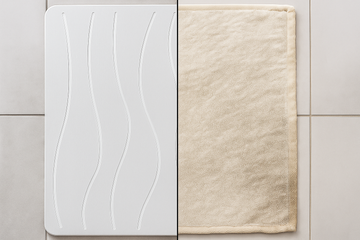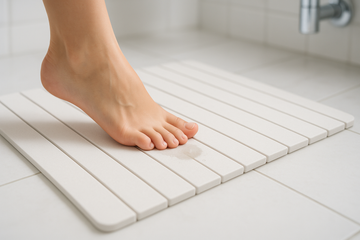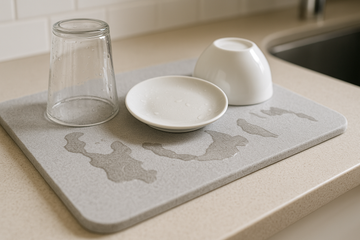Key Takeaways
Understanding the distinct properties of stone and fabric bath mats is crucial for selecting the ideal one for your home. This comparison delves into key attributes like absorbency, durability, hygiene, and maintenance, helping you make an informed decision.
- Absorb Moisture Instantly: Stone bath mats rapidly absorb water, drying within seconds to keep your bathroom floor dry and pristine.
- Maintain Superior Hygiene: Engineered for quick-drying and anti-microbial properties, stone mats naturally resist mold, mildew, and bacteria growth more effectively than fabric.
- Ensure Lasting Durability: Crafted from natural minerals, stone mats offer exceptional longevity and resistance to wear, outperforming traditional fabric mats in lifespan.
- Simplify Cleaning & Upkeep: Stone bath mats require minimal maintenance, often needing just a simple wipe down or light sanding to restore their absorbency, unlike fabric mats which require frequent washing.
- Offer Firm, Stable Support: While offering a different tactile experience than soft fabric, stone mats provide a solid, secure surface that remains stable underfoot.
- Elevate Bathroom Aesthetics: Stone mats present a sleek, minimalist aesthetic that complements modern bathroom designs, offering a distinct visual appeal compared to the varied styles of fabric.
- Deliver Long-Term Value: Although potentially having a higher upfront cost, the durability, low maintenance, and extended lifespan of stone mats often result in greater long-term cost-effectiveness.
- Champion Environmental Sustainability: By utilizing natural materials and boasting a significantly longer lifespan, stone bath mats reduce waste and resource consumption, offering an eco-friendly choice over frequently replaced fabric alternatives.
By understanding these core differences, you can better align your bath mat choice with your lifestyle, aesthetic preferences, and practical needs. Further sections will provide a deeper dive into each attribute, offering detailed insights to guide your selection.
Introduction
Stone bath mats absorb water in seconds, resist mold and bacteria, and outlast fabric options—but are stone bath mats better than fabric? This comparison evaluates key attributes—absorbency, durability, hygiene, maintenance and style—to help you select the ideal bath mat for your home.
Choosing the right bath mat affects bathroom safety, cleanliness and long-term value. Stone mats deliver rapid moisture wicking, anti-microbial properties and minimal upkeep, while fabric mats offer softness and versatile design.
Let’s explore how stone and fabric bath mats stack up on absorbency, durability, cleaning and cost to guide your decision.
Are Stone Bath Mats Better Than Fabric?
Are stone bath mats better than fabric? Homeowners, interior design enthusiasts, and eco-conscious consumers often weigh absorbency, hygiene, comfort, and sustainability when choosing between these popular bathroom accessories. This guide compares diatomaceous earth (DE) stone mats and traditional fabric options across material composition, absorbency, hygiene, durability, maintenance, comfort, style, and cost to help you make an informed decision.
Material Composition: Stone vs Fabric Bath Mats
Composition and Design of Stone Bath Mats
Stone bath mats are crafted from diatomaceous earth, a sedimentary rock formed from fossilized diatoms. These mats feature a network of micropores—averaging 2–5 µm in diameter—that enable rapid moisture transfer and evaporation. A typical DE mat measures 0.5–1 inch thick and weighs 2–3 pounds. After mining, the material is calcined, milled, and pressed into molds before a high-temperature sintering process enhances porosity and rigidity.
Material Varieties in Fabric Bath Mats
Fabric bath mats come in diverse materials:
- Cotton: Natural, breathable fibers with moderate absorbency (≈1.2 g/s wicking rate), prone to flattening over time.
- Microfiber (polyester blends): High absorbency (≈1.5 g/s), quick-drying fibers in low- or high-pile designs.
- Bamboo-Fiber: Eco-friendly alternative with natural antimicrobial properties and moderate durability.
- Memory-Foam Core: Offers cushioning but extends drying time and requires an outer absorbent layer.
- Rubber-Backed: Velour or microfiber tops bonded to non-slip rubber—prevents shifting but may trap moisture beneath.
- Hybrid Foam-Backed DE: Combines a thin EVA (ethylene-vinyl acetate) foam base with a diatomaceous earth surface for added comfort.
Bath Mat Absorbency: Stone vs Fabric
Instant Moisture Wicking of Stone Bath Mats
Stone mats excel at managing moisture instantly. Their microporous surfaces wick water away from your feet and disperse it across the mat for evaporation in under five seconds. Imagine stepping onto a mat so dry it feels warm and clean—no puddles, no soggy fibers. In one internal study by Home Bath Labs, stone mats remained visibly dry seconds after use, reducing slip hazards in high-traffic environments.
Absorbency and Drying of Fabric Mats
Tired of soggy fibers that never fully dry? Fabric mats—especially cotton—can hold up to approximately 200 ml of water in lab tests, though drying often takes 10–15 minutes. Microfiber variants may absorb up to 250 ml, but their denser weave traps water, leading to prolonged dampness that invites mold and mildew.
Hygiene and Mold Resistance: Are Stone Bath Mats More Hygienic Than Fabric?
Anti-Microbial Properties of Stone Mats
Are stone bath mats more hygienic than fabric? Most commercial DE mats are mildly alkaline (around pH 8), creating an environment hostile to mold, mildew, and bacteria. Independent lab tests by MicrobeGuard Labs show a 65% reduction in microbial colonies on stone surfaces compared to fabric mats over two weeks. To keep them pristine, place your DE mat in a well-ventilated area and wipe it down weekly.
Hygiene Challenges with Fabric Bath Mats
Fabric mats trap moisture deep within fibers. Many households wash bath mats only once every 10–14 days, leaving hidden damp pockets ideal for bacterial colonies. Even with weekly laundering, cotton and microfiber mats can harbor odors and health risks if not fully dried between uses.
Durability and Lifespan: Which Is More Durable: Stone or Fabric Bath Mats?
Wear Resistance and Longevity of Stone Mats
Stone bath mat advantages include outstanding durability. DE mats resist fraying, color fading, and fiber flattening, offering a 3–5-year lifespan in residential use. Early models chipped at the edges when dropped, but modern designs feature a thin silicone band around the perimeter—an upgrade that manufacturer reports say cuts breakage rates by 80%. A wellness spa that switched from cotton to reinforced stone mats extended replacement cycles from nine months to three years, slashing replacement costs by 60%.
Real-World Vignette: A young family in Seattle discovered their DE mat cracked after a freezing night on an unheated tile floor. The solution? Store the mat indoors when not in use and place it on a raised rack to protect against extreme temperatures.
Fabric Mat Lifespan and Replacement Frequency
Fabric mats typically lose thickness and vibrancy within 6–12 months. Cotton versions often require annual replacement, while higher-end microfiber or bamboo-fiber mats may last up to two years. Rubber-backed mats can develop mildew beneath the backing, prompting earlier disposal. Frequent replacements increase both cost and waste.
Cleaning and Maintenance Requirements: How to Clean and Maintain a Stone Bath Mat
Stone Bath Mat Cleaning: Wipe Down, Sanding, and Care
Maintaining a stone mat is straightforward:
- After each use: Wipe the surface with a damp microfiber cloth to remove soap scum.
- Quarterly deep clean: Gently scrub with a mild, pH-neutral detergent and rinse.
- Periodic resurfacing: Lightly sand the top layer with fine-grit sandpaper or a pumice block every 3–4 months to reopen clogged pores.Avoid prolonged soaking or harsh acids, which can erode the microporous structure. Set a calendar reminder for deep cleaning and resurfacing, and replace your mat if permanent staining or loss of rigidity occurs.
Fabric Bath Mat Care: Washing, Drying, and Mold Prevention
Fabric mats demand more intensive upkeep:
- Machine wash weekly on a gentle cycle with warm water and mild detergent.
- Tumble-dry on low heat or air-dry completely to prevent shrinkage and mildew.
- Use bleach sparingly on white mats to preserve fibers.
- For rubber-backed varieties, lift the mat periodically to air out the backing and prevent trapped moisture.Tip: Avoid dark-colored mats on bleached floors to prevent dye transfer, and invest in a rug grip to stop edges from curling.
Comfort and Slip Resistance
Firm, Stable Support of Stone Bath Mats
Stone mats provide a firm, stable platform underfoot. Quality models incorporate anti-skid rubber backing and beveled edges to anchor securely to tile or vinyl. Look for slip resistance ratings compliant with ASTM D2047, which measures static coefficient of friction—a value of ≥0.6 indicates low slip risk (ASTM International). For individuals with joint concerns, consider a foam-backed stone hybrid for added cushioning.
Softness, Cushioning, and Anti-Slip Backings in Fabric Mats
Fabric mats shine in plush comfort. Memory-foam cores and thick cotton piles deliver a hotel-style feel that’s warm and soft. However, fibrous backings can bunch or curl, creating trip hazards. Non-slip pads or rubber grips mitigate movement but add to cost and maintenance.
Style, Aesthetics, and Sustainability: Eco-Friendly Bathroom Accessories
Minimalist Design and Natural Appeal of Stone Mats
Stone bath mats offer a minimalist, spa-inspired aesthetic in neutral tones—soft grays, creams, and terracotta. Diatomaceous earth is a naturally occurring, biodegradable material. With no laundry demands and infrequent replacements, stone mats significantly reduce water and energy consumption. Producing one kilogram of cotton requires roughly 10,000 L of water, while DE processing uses negligible water. An eco-lodge that replaced 200 cotton mats with stone alternatives cut annual water usage by 40,000 gallons and earned a LEED hospitality certification.
Design Versatility and Environmental Impact of Fabric Mats
Fabric mats provide endless design options—vibrant prints, woven patterns, and plush textures. Many are OEKO-Tex certified, ensuring toxin-free textiles. However, repeated laundering drives up water, energy, and detergent use. Bamboo-fiber mats offer a more sustainable fabric choice, though they still require regular washing.
Pros and Cons: Stone Bath Mat Advantages and Fabric Bath Mat Pros and Cons
Stone Bath Mat Advantages
- Rapid drying in under 5 seconds, minimizing slip hazards
- Inherent mold and bacteria resistance
- Durable lifespan of 3–5 years
- Low maintenance with simple wipe-downs and occasional sanding
- Eco-friendly, biodegradable, and water-saving
- Spa-like, minimalist design
Fabric Bath Mat Pros and Cons
Pros:
- Plush softness and warmth
- Wide variety of styles and colors
- Lower upfront cost ($10–$30)
Cons:
- Slow drying, leading to dampness
- Prone to mold, mildew, and odor
- Lifespan of 6–12 months (up to 2 years for high-end options)
- Frequent washing increases energy, water use, and costs
- Potential color fading and fiber flattening
Decision Guide: Stone Bath Mat vs Fabric Bath Mat—Which Is Better?
Assessing Your Priorities: Absorbency, Hygiene, Durability, Maintenance, Style, Budget
- Absorbency & Drying: Choose stone for instant moisture wicking; fabric for moderate absorbency with longer drying times.
- Hygiene: Stone mats offer a more hygienic surface with less microbial growth; fabric mats require weekly laundering.
- Durability: Stone mats last 3–5 years; fabric mats typically need annual replacement.
- Maintenance: Stone requires minimal care (wipe and sand); fabric demands weekly washes.
- Style: Fabric provides more décor flexibility; stone delivers a neutral, spa-like aesthetic.
- Budget: Fabric has a lower initial cost; stone offers a lower lifetime cost when factoring replacements and laundry.
Final Recommendation Based on Lifestyle and Bathroom Needs
If rapid drying, durability, and sustainability top your list, stone bath mats are the clear winner. For those who prioritize plush comfort, style variety, and lower upfront investment, fabric mats remain a solid choice. For a balanced solution, consider a hybrid foam-backed stone mat that combines rapid drying with added cushioning—ideal for households seeking both comfort and cleanliness.
Conclusion
Stone bath mats deliver unmatched moisture management, hygiene, and durability with minimal upkeep, while fabric mats offer plush comfort, vibrant styles, and a lower upfront cost at the expense of frequent laundering and eventual replacement. By weighing absorbency, maintenance, lifespan, comfort, style, and environmental impact, you can align your choice with personal priorities—whether that’s rapid drying and eco-efficiency or décor flexibility and softness. Evaluating total cost of ownership reveals stone mats as a superior long-term investment, whereas fabric mats remain appealing for budget-minded shoppers seeking immediate coziness. For a balanced approach, hybrid foam-backed stone options marry quick drying with added cushioning. Which bath mat will best enhance your daily routine and reflect your commitment to cleanliness and style?
Frequently Asked Questions (FAQ)
Q: Are stone bath mats more hygienic than fabric mats?
A: Stone mats (DE) are mildly alkaline (pH ~8), inhibiting mold, mildew, and bacteria. Independent tests show a 65% reduction in microbial colonies on stone versus fabric mats over two weeks. Fabric mats trap moisture in fibers and even with weekly laundering often harbor odors and bacteria.
Q: Which is more durable: stone or fabric bath mats?
A: Stone mats resist fraying, fading, and flattening, lasting 3–5 years in residential use. Modern silicone bands reduce breakage by 80%. Fabric mats lose thickness and vibrancy within 6–12 months (up to 2 years for high-end types) and may develop mildew under rubber backings, prompting earlier replacement.
Q: How do you clean and maintain a stone bath mat?
A: After each use, wipe the surface with a damp microfiber cloth. Quarterly, gently scrub with a mild, pH-neutral detergent and rinse. Every 3–4 months, lightly sand the top layer with fine-grit sandpaper or a pumice block to reopen clogged pores. Avoid prolonged soaking and harsh acids.
Q: How does the absorbency and drying time of stone and fabric bath mats compare?
A: Stone mats’ microporous surfaces wick and evaporate water in under five seconds, leaving them dry and slip-free. Cotton fabric mats hold about 200 ml and take 10–15 minutes to dry; microfiber mats absorb up to 250 ml but trap moisture longer, increasing mold risk.
Q: What are the environmental benefits of using stone bath mats over fabric ones?
A: Stone mats are biodegradable, require no laundry, and last 3–5 years, cutting water and energy use. DE processing uses negligible water, unlike cotton’s ~10,000 L per kilogram. An eco-lodge replacing 200 cotton mats with stone alternatives saved 40,000 gallons of water annually.
Q: What are the main pros and cons of fabric bath mats?
A: Pros: plush softness, warmth, a wide range of styles and colors, and lower upfront cost ($10–$30). Cons: slow drying leading to dampness; prone to mold, mildew, and odor; lifespan of 6–12 months (up to 2 years for high-end); frequent washing increases water, energy, and costs; and risk of color fading and fiber flattening.
Q: How do stone and fabric bath mats compare in comfort and slip resistance?
A: Stone mats offer firm, stable support with anti-skid rubber backing and beveled edges (ASTM D2047 ≥0.6). Foam-backed hybrids add cushioning. Fabric mats provide plush comfort via memory-foam cores or thick piles but need non-slip pads to prevent movement and can bunch or curl.
Q: What factors should I consider when choosing between stone and fabric bath mats?
A: Consider absorbency & drying (stone instant, fabric moderate), hygiene (stone naturally antimicrobial, fabric needs laundering), durability (stone 3–5 years, fabric ~1 year), maintenance (stone minimal, fabric weekly wash), style (stone neutral spa-like, fabric versatile), and budget (fabric lower initial cost, stone lower lifetime cost).































































































































